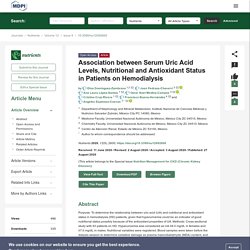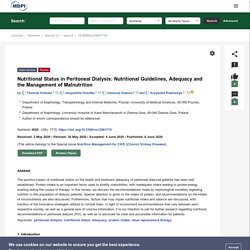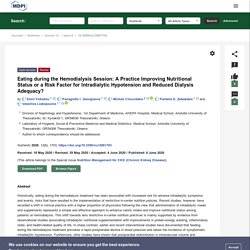

Impact of Annual Change in Geriatric Nutritional Risk Index on Mortality in Patients Undergoing Hemodialysis. 1.

Introduction. Association between Serum Uric Acid Levels, Nutritional and Antioxidant Status in Patients on Hemodialysis. Purpose: To determine the relationship between uric acid (UA) and nutritional and antioxidant status in hemodialysis (HD) patients, given that hyperuricemia could be an indicator of good nutritional status possibly because of the antioxidant properties of UA.

Methods: Cross-sectional study with 93 patients on HD. Hyperuricemia was considered as UA ≥6.0 mg/dL in females and ≥7.0 mg/dL in males. Nutritional variables were registered. Blood samples were taken before the dialysis session to determine oxidative damage as plasma malondialdehyde (MDA) content, and antioxidant capacity measuring 2,2-diphenyl-piclrylhidrazil radical (DPPH●) scavenging activity and oxygen radical absorbance capacity (ORAC) value. Causes of Vitamin K Deficiency in Patients on Haemodialysis. Background: A low vitamin K status is common in patients on haemodialysis, and this is considered one of the reasons for the accelerated atherosclerosis in these patients.

The vitamin is essential in activation of the protein Matrix Gla Protein (MGP), and the inactive form, dp-ucMGP, is used to measure vitamin K status. The purpose of this study was to investigate possible underlying causes of low vitamin K status, which could potentially be low intake, washout during dialysis or inhibited absorption capacity. Moreover, the aim was to investigate whether the biomarker dp-ucMGP is affected in these patients. Pilot Randomized Controlled Trial of a Standard versus a Modified Low Phosphorus Diet inHemodialysis Patients - Kidney International Reports. Introduction Hyperphosphataemia is common in end stage kidney disease (ESKD) and is associated with excess morbidity and mortality.

Dietary phosphorus restriction is suggested to control hyperphosphataemia. KDIGO. Oral protein-based nutritional supplement in people with chronic kidney disease requiring dialysis. Twenty-two studies (1278 participants) were included in this review.

All participants were adults on maintenance dialysis of whom 79% were on haemodialysis (HD) and 21% peritoneal dialysis. The follow-up period ranged from one to 12 months. The majority of studies were at unclear risk of selection, performance, and reporting bias. The detection bias was high for self-reported outcomes. Oral protein-based nutritional supplements probably lead to a higher mean change in serum albumin compared to the control group (16 studies, 790 participants: MD 0.19 g/dL, 95% CI 0.05 to 0.33; moderate certainty evidence), although there was considerable heterogeneity in the combined analysis (I2 = 84%). There may be little or no difference in the risk of developing gastrointestinal intolerance between participants who received oral protein-based nutritional supplements compared with placebo or no supplement (6 studies, 426 participants: RR 2.81, 95% CI 0.58 to 13.65, low certainty evidence). - A Dietary Mobile App for Patients Undergoing Hemodialysis: Prospective Pilot Study to Improve Dietary Intakes.
Introduction Mobile technology has the potential to improve health care coverage, especially in low- to middle-income countries where people may be more likely to have access to a smartphone than to basic needs such as safe water and electricity [].

Self-tracking and wearable technologies have become popular, particularly in the areas of diet and fitness []. Previous research on mobile health (mHealth) interventions provides evidence regarding their effectiveness [-]. Nutritional Status in Peritoneal Dialysis: Nutritional Guidelines, Adequacy and the Management of Malnutrition. Children have unique nutritional demands.

Inadequate nutritional status in children younger than five years of age results in detrimental loss of development and lasting health disparities [71]. What is more, nutrition plays a vital role in the development of the brain during the postnatal and preschool periods, as neurons undergo rapid development and synaptic pruning during the first five years of life. Unfortunately, children who suffer from CKD are faced with impaired nutritional status directly resulting in sub-optimal growth [72]. This may be attributed to growth hormone and insulin-like growth factor I axis dysregulation, metabolic acidosis, anemia, nutritional deficiencies, renal osteodystrophy and inflammation [72]. Eating during the Hemodialysis Session: A Practice Improving Nutritional Status or a Risk Factor for Intradialytic Hypotension and Reduced Dialysis Adequacy?
The exact incidence of intradialytic hypotension is difficult to be quantified with precision in the absence of standardized definitions of this complication.

According to the 2007 EBPG recommendations, intradialytic hypotension should be defined as a drop in systolic BP ≥20 mmHg or a decline in mean BP of at least 10 mmHg being accompanied by adverse intradialytic symptoms/events or necessitating nursing interventions [8]. However, this rigorous definition has not been consistently adopted in clinical research. In a 2019 meta-analysis of 5 studies (incorporating data from 1694 participants), the prevalence of intradialytic hypotension (as per the EBPG definition) was 10.1% [95% confidence interval (CI): 6.1–16.5%], with prevalence rate ranging from 5.0% to 30.8% across these 5 studies [18].
This meta-analytic evidence highlights the unmet need for universally accepted definitions as an approach to estimate the real incidence of intradialytic hypotension. Management of Hyperphosphatemia in End-Stage Renal Disease: A New Paradigm - Journal of Renal Nutrition. Kidney Disease: Improving Global Outcomes (KDIGO) CKD-MBD Update Work GroupKDIGO 2017 Clinical Practice Guideline Update for the Diagnosis, Evaluation, Prevention, and Treatment of Chronic Kidney Disease-Mineral and Bone Disorder (CKD-MBD).Kidney Int Suppl (2011). 2017; 7: 1-59Zhou C.

Wang F. Wang J.W. Zhang L.X. Zhao M.H. Exercise in patients on chronic hemodialysis: current eviden... : Current Opinion in Clinical Nutrition & Metabolic Care. Purpose of review Physical inactivity is common in hemodialysis patients, and is associated with disability and poor outcomes.

We summarize the effects of aerobic, resistance or mixed exercise training on aerobic capacity, muscle mass and strength, dialysis efficiency, quality of life and cardiovascular adaptation according to clinical studies on this population, also focusing on knowledge gaps as topics for future research. Clinical practice guideline on undernutrition in chronic kidney disease. 1.2.1 - We suggest that there should be a clear pathway for prompt referral to specialist renal dietitians when risk of undernutrition is identified. This pathway should include locally agreed timescales for formal assessment. (2D). 1.2.2 - We suggest that patients should be assessed by a specialist renal dietitian when they begin education about renal replacement treatment and within one month of starting dialysis or changing dialysis modality (2D). 1.2.3 - We suggest that formal nutritional assessments are carried out on those identified to be at risk by screening.
These diagnostic assessments will typically be performed by specialist renal dietitians with support from the broader multidisciplinary team. (2B). Rationale Our recommendations aim to ensure that services have clear pathways for referral to specialist renal dietitians. People deemed to be at risk of undernutrition should be referred for assessment. Changes in social circumstances may influence the availability of food. Obesity and Mortality in End-Stage Renal Disease. Is It Time to Reverse the “Reverse Epidemiology”—at Least in Peritoneal Dialysis? - Journal of Renal Nutrition.
Antioxidant Supplementation in Renal Replacement Therapy Patients: Is There Evidence? Malnutrition Risk in Hemodialysis Patients in Israel: Results of the Status of Nutrition In Hemodialysis Patients Survey Study - Abstract - Nephron 2019, Vol. 141, No. 3. Clinical Practice: Original Paper To view the fulltext, please log in To view the pdf, please log in Buy FullText & PDF Unlimited re-access via MyKarger Unrestricted printing, no saving restrictions for personal use read more Select Buy a Karger Article Bundle (KAB) and profit from a discount!
If you would like to redeem your KAB credit, please log in. Save over 20% compared to the individual article price. Learn more Rent/Cloud Rent for 48h to view Buy Cloud Access for unlimited viewing via different devices Synchronizing in the ReadCube Cloud Printing and saving restrictions apply Rental: USD 9.50 Cloud: USD 24.00 Select Subscribe Access to all articles of the subscribed year(s) guaranteed for 5 years Unlimited re-access via Subscriber Login or MyKarger Unrestricted printing, no saving restrictions for personal use read more Subcription rates Select * The final prices may differ from the prices shown due to specifics of VAT rules. Article / Publication Details. Overview of the 2017 KDIGO CKD-MBD Update: Practice Implications for Adult Hemodialysis Patients - Journal of Renal Nutrition. Use of Intradialytic Parenteral Nutrition in Patients Undergoing Hemodialysis - Sarav - 2018 - Nutrition in Clinical Practice. Nutritional management of the vegan with end-stage kidney disease.
Nazeema Esau Tygerberg Hospital Zarina Ebrahim Stellenbosch University Keywords: nutritional management, vegan, end-stage kidney disease Abstract Chronic kidney disease (CKD) is associated with nutritional complications such as anaemia, electrolyte imbalances, bone-mineral disorders, malnutrition and cardiovascular disease.1 The nutritional management in CKD is very complex since it includes multiple dietary factors e.g. the intake of protein, energy, sodium, phosphorus and potassium.
Protein energy malnutrition is widely prevalent in this population, however recently obesity has also become more common. Poor dietary compliance often occurs in patients prescribed renal diets because it is known to be unpalatable and very restrictive with major lifestyle changes required.2,3 In a patient following a vegan diet, the complexity of dietary management increases due to further limitations in meeting specifically protein and micronutrient requirements.
Author Biographies Section. Obesity and Mortality in End-Stage Renal Disease. Is It Time to Reverse the “Reverse Epidemiology”—at Least in Peritoneal Dialysis? Renal replacement therapy and conservative management. Dietary management of fluid for haemodialysis: consensus statement. Dietary protein and nutritional supplements in conventional hemodialysis - Sabatino - - Seminars in Dialysis. Renal Association Clinical Practice Guideline on peritoneal dialysis in adults and children. Peritoneal dialysis (PD) (guidelines PD 1.1–1.5) Guideline 1.1 – PD: Equipment and resources We recommend that Peritoneal Dialysis should be delivered in the context of a comprehensive and integrated service for renal replacement therapies, including haemodialysis (including temporary backup facilities), transplantation and conservative care. Both continuous ambulatory peritoneal dialysis (CAPD) and automated peritoneal dialysis (APD), in all its forms should be available (1C).
Guideline 1.1.2 – PD: Equipment and resources We recommend that a dedicated PD nursing team should be part of the multidisciplinary team (1C). Guideline 1.1.3 – PD: Equipment and resources We recommend that where feasible, each unit has a designated lead clinician for PD (1C). Guideline 1.1.4 – PD: Equipment and resources Rationale PD modalities (CAPD v. Eating During Hemodialysis Treatment: A Consensus Statement From the International Society of Renal Nutrition and Metabolism - Journal of Renal Nutrition. Water soluble vitamins and peritoneal dialysis – State of the art.